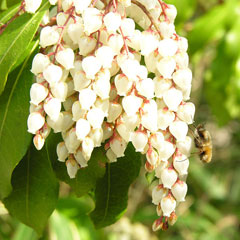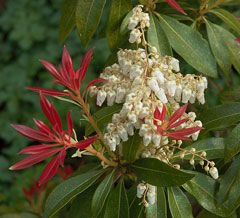 |
|
http://commons.wikimedia.org/wiki/User:Tarabagani |
 |
| http://commons.wikimedia.org/wiki/User:Wouterhagens |
Translate this page:
Summary
Bloom Color: White. Main Bloom Time: Early spring, Late spring, Mid spring. Form: Oval.
Physical Characteristics

 Pieris japonica is an evergreen Shrub growing to 4 m (13ft) by 4 m (13ft) at a slow rate.
Pieris japonica is an evergreen Shrub growing to 4 m (13ft) by 4 m (13ft) at a slow rate.
See above for USDA hardiness. It is hardy to UK zone 5 and is not frost tender. It is in leaf all year, in flower from April to May, and the seeds ripen from August to October. The species is hermaphrodite (has both male and female organs).
Suitable for: light (sandy), medium (loamy) and heavy (clay) soils. Suitable pH: mildly acid soils and can grow in very acid soils.
It can grow in full shade (deep woodland) semi-shade (light woodland) or no shade. It prefers moist soil.
UK Hardiness Map
US Hardiness Map
Synonyms
P. taiwanensis. P. yakushimensis. Andromeda japonica.
Plant Habitats
Woodland Garden Dappled Shade; Shady Edge; not Deep Shade;
Edible Uses
References More on Edible Uses
Medicinal Uses
Plants For A Future can not take any responsibility for any adverse effects from the use of plants. Always seek advice from a professional before using a plant medicinally.
None known
References More on Medicinal Uses
The Bookshop: Edible Plant Books
Our Latest books on Perennial Plants For Food Forests and Permaculture Gardens in paperback or digital formats.

Edible Tropical Plants
Food Forest Plants for Hotter Conditions: 250+ Plants For Tropical Food Forests & Permaculture Gardens.
More

Edible Temperate Plants
Plants for Your Food Forest: 500 Plants for Temperate Food Forests & Permaculture Gardens.
More

More Books
PFAF have eight books available in paperback and digital formats. Browse the shop for more information.
Shop Now
Other Uses
The plant is used as a pesticide and a parasiticide[174].
Special Uses
Scented Plants
References More on Other Uses
Cultivation details
Landscape Uses:Border, Massing, Screen, Specimen, Woodland garden. Easily grown in a moist acid peaty soil but it requires a sheltered position because the young growth is easily damaged by frost[11, 182, 184, 200]. Plants grow best with a western exposure so that they are protected from morning frosts[11]. They flower more freely when grown in a sunny position[200]. Best grown in shade or semi-shade[188], they grow well in a woodland garden[200]. Dormant plants are hardy to about -20°c[184]. A very ornamental plant, there are many named varieties[182, 200]. The flowers are delicately scented[245]. A slow growing plant[200]. Plants sometimes succumb to an incurable fungal infection[200]. Plants in this genus are notably resistant to honey fungus[200]. Special Features:Not North American native, Blooms are very showy.
References Carbon Farming Information and Carbon Sequestration Information
Temperature Converter
Type a value in the Celsius field to convert the value to Fahrenheit:
Fahrenheit:
The PFAF Bookshop
Plants For A Future have a number of books available in paperback and digital form. Book titles include Edible Plants, Edible Perennials, Edible Trees,Edible Shrubs, Woodland Gardening, and Temperate Food Forest Plants. Our new book is Food Forest Plants For Hotter Conditions (Tropical and Sub-Tropical).
Shop Now
Plant Propagation
Seed - surface sow in the spring on a fine moss peat. Keep the compost moist and place the pot in a shaded part of the greenhouse[200]. When they are large enough to handle, prick the seedlings out into individual pots and grow them on in a shady part of the greenhouse for at least their first winter. Plant them out into their permanent positions in late spring or early summer, after the last expected frosts. Cuttings of short side branches with a heel, August/September in a frame[1]. Layering. Offsets.
Other Names
If available other names are mentioned here
Native Plant Search
Search over 900 plants ideal for food forests and permaculture gardens. Filter to search native plants to your area. The plants selected are the plants in our book 'Plants For Your Food Forest: 500 Plants for Temperate Food Forests and Permaculture Gardens, as well as plants chosen for our forthcoming related books for Tropical/Hot Wet Climates and Mediterranean/Hot Dry Climates. Native Plant Search
Found In
Countries where the plant has been found are listed here if the information is available
Weed Potential
Right plant wrong place. We are currently updating this section.
Please note that a plant may be invasive in one area but may not in your area so it’s worth checking.
Conservation Status
IUCN Red List of Threatened Plants Status :

Growth: S = slow M = medium F = fast. Soil: L = light (sandy) M = medium H = heavy (clay). pH: A = acid N = neutral B = basic (alkaline). Shade: F = full shade S = semi-shade N = no shade. Moisture: D = dry M = Moist We = wet Wa = water.

Expert comment
Author
(Thunb.)D.Don.
Botanical References
11200266
Links / References
For a list of references used on this page please go here
Readers comment
© 2010, Plants For A Future. Plants For A Future is a charitable company limited by guarantee, registered in England and Wales. Charity No. 1057719, Company No. 3204567.